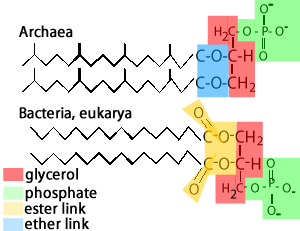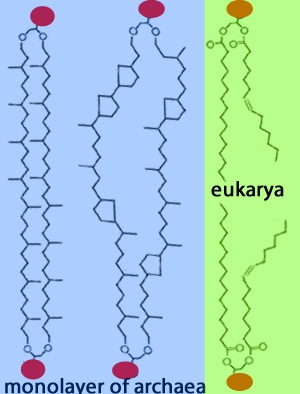
In 1990 a three domain system, developed by Carl Woese, was added on top of the kingdoms. This system recognised the distinction between two groups of prokaryotic cells and the four eukaryotic kingdoms namely plantae, animalia, fungi and protista. Each domain is further divided into kingdoms represented by branches in the diagram above.
The three domains were proposed as a result of differences in the biochemistry between species. Differences, such as cell membrane structure and degree of similarity in the genes that code of ribosomal RNA. Ribosomes are present in all living organisms and differences in the structural material of ribosomes, that being ribosomal RNA, gives an indication of the evolutionary history between prokaryotes and eukaryotes. Each domain is divided into kingdoms as shown above.
The three domains are:
-
Bacteria
- Archaea - These type of cells have evolved separately and show distinct differences in their biochemical pathways from other forms of life. They were originally referred to as extremophiles due to their ability to survive in extremely harsh conditions such as acidic and salty conditions as well as high temperatures, but they have since been discovered in less harsh environments such as the oceans.
- Eukarya
- Includes eukaryotic cells that form organisms ranging from single celled organisms such as the paramecium and euglena to fungi and more complex animals. This domain is further subdivided into the kingdoms Protista, Fungi, Plantae, and Animalia.
Some of the biochemical differences between archaea and the other two domains are listed below.
1) Bacteria and eukarya have membranes made of phospholipids with an ester bond, as shown on the right. Instead of an ester link archaea have an ether link. Ether links are more chemically stable than ester links which is better for life in harsh acidic environments.
Archaea do not use fatty acids to build their membranes, as do bacteria and eukarya, instead they use isoprene which provides for side branching.


3) Carbon atoms on the side chains of the lipid molecules forming the membrane of the archaea can bond to form ring structures, as shown on the right. Ring structures make the membrane more stable in conditions of high heat.
The monolayer also makes the Archaean membrane less permeable than the eukaryan membrane which is beneficial for life in harsh conditions.

2) Woese's system of three domains uses structural features such as membrane structure to classify organisms
|
||||||
DOMAIN |
Bacteria |
Archaea |
Eukarya |
|||
| Kingdom | Eubacteria | Archaebacteria | Protista | Fungi | Plantae | Animalia |
Prokaryote/eukaryote |
Prokaryote |
Prokaryote |
Eukaryote |
Eukaryote |
Eukaryote |
Eukaryote |
Distinguishing features |
Cell walls contain peptidoglycan |
Cell walls without peptidoglycan |
Some have cell walls of cellulose and some have chloroplasts |
Cell walls made of chitin |
Cell walls made of cellulose some contain chloroplasts |
No cell walls or chloroplasts |
Unicellular/multicellular |
Unicellular |
Unicellular |
Most unicellular; some multicellular |
Multicellular and some unicellular |
Multicellular |
Multicellular |
Autotroph/ Heterotroph |
Autotroph or heterotroph |
Autotroph or heterotroph |
Autotroph or heterotroph |
Heterotroph |
Autotroph |
Heterotroph |
6) According to the table above, what is the main difference between bacteria and archaea?
7) An organism is unicellular, with a cell wall and an heterotroph.
a) Can the table above be used to classify the organism into its domain? Explain.
b) What information would be needed in order to classify the organism into its domain and kingdom?
8) Which of the following contain more than one kingdom?